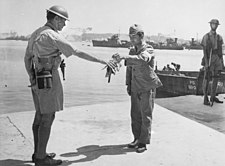British Commonwealth Occupation Force

30 August 1945. Yokosuka Naval Base, Tokyo Bay. Commander Yuzo Tanno hands over the keys of the Yokosuka Naval Base to Captain H. J. Buchanan, Royal Australian Navy. Buchanan led the first British Commonwealth party to go ashore in Japan.

General Robert L. Eichelberger inspects the Australian Guard of Honour at Kure.
The British Commonwealth Occupation Force (BCOF) was the joint Australian, British, Indian and New Zealand military forces in occupied Japan, from 21 February 1946 until the end of occupation in 1952. At its peak, the BCOF comprised about 40,000 personnel, equal to about 25% of the number of US military personnel in Japan.
Contents
1 History and role
2 References
3 Further reading
4 External links
History and role
Whilst US forces were responsible for military government, the BCOF was responsible for supervising demilitarisation and the disposal of Japan's war industries.[1] The BCOF was also responsible for the occupation of the western prefectures of Shimane, Yamaguchi, Tottori, Okayama, Hiroshima and Shikoku Island. They were also supported by the Women's Auxiliary Service (Burma). BCOF headquarters was at Kure.
For most of the occupation period Australia contributed the majority of the BCOF's personnel. The initial BCOF presence included the Australian 34th Brigade; the 9th Brigade, 2nd New Zealand Expeditionary Force (J Force); and BRINDIV, a British/Indian division of two brigade groups: the British 5th Infantry Brigade Group (from 2nd Infantry Division in India), and the 268th Indian Infantry Brigade. Major General David Cowan commanded BRINJAP Division from 1945 to 1947. The position of commanding officer was always filled by an Australian: Lieutenant General John Northcott, February to June 1946; Lieutenant General Horace Robertson, June 1946 to November 1951, and Lieutenant General William Bridgeford from November 1951 until the end of the occupation.

May 1946. The 2nd Battalion, 5th Royal Gurkha Rifles marching through Kure soon after their arrival in Japan.
The British Pacific Fleet initially provided most of the naval forces. The air contingent, known as BCAIR, initially comprised the Royal Australian Air Force's No. 81 Fighter Wing, flying P-51 Mustangs, four Spitfire squadrons (including No. 11 and No. 17 of the Royal Air Force and No. 4 of the Indian Air Force), and No. 14 Squadron of the Royal New Zealand Air Force flying F4U Corsairs.
During 1947, the BCOF began to wind down its presence in Japan. However, BCOF bases provided staging posts for Commonwealth forces deployed to the Korean War, from 1950 onwards. The BCOF was effectively wound-up in 1951, as control of Commonwealth forces in Japan was transferred to British Commonwealth Forces Korea.
References
^ British Commonwealth Occupation Force 1945–52, AWM
Further reading
Singh, Rajendra (1958). Post-War Occupation Forces: Japan and South-East Asia. Delhi: Combined Inter-Services Historical Section (India & Pakistan) India, Orient Longmans [distributor]. OCLC 518916..mw-parser-output cite.citationfont-style:inherit.mw-parser-output .citation qquotes:"""""""'""'".mw-parser-output .citation .cs1-lock-free abackground:url("//upload.wikimedia.org/wikipedia/commons/thumb/6/65/Lock-green.svg/9px-Lock-green.svg.png")no-repeat;background-position:right .1em center.mw-parser-output .citation .cs1-lock-limited a,.mw-parser-output .citation .cs1-lock-registration abackground:url("//upload.wikimedia.org/wikipedia/commons/thumb/d/d6/Lock-gray-alt-2.svg/9px-Lock-gray-alt-2.svg.png")no-repeat;background-position:right .1em center.mw-parser-output .citation .cs1-lock-subscription abackground:url("//upload.wikimedia.org/wikipedia/commons/thumb/a/aa/Lock-red-alt-2.svg/9px-Lock-red-alt-2.svg.png")no-repeat;background-position:right .1em center.mw-parser-output .cs1-subscription,.mw-parser-output .cs1-registrationcolor:#555.mw-parser-output .cs1-subscription span,.mw-parser-output .cs1-registration spanborder-bottom:1px dotted;cursor:help.mw-parser-output .cs1-ws-icon abackground:url("//upload.wikimedia.org/wikipedia/commons/thumb/4/4c/Wikisource-logo.svg/12px-Wikisource-logo.svg.png")no-repeat;background-position:right .1em center.mw-parser-output code.cs1-codecolor:inherit;background:inherit;border:inherit;padding:inherit.mw-parser-output .cs1-hidden-errordisplay:none;font-size:100%.mw-parser-output .cs1-visible-errorfont-size:100%.mw-parser-output .cs1-maintdisplay:none;color:#33aa33;margin-left:0.3em.mw-parser-output .cs1-subscription,.mw-parser-output .cs1-registration,.mw-parser-output .cs1-formatfont-size:95%.mw-parser-output .cs1-kern-left,.mw-parser-output .cs1-kern-wl-leftpadding-left:0.2em.mw-parser-output .cs1-kern-right,.mw-parser-output .cs1-kern-wl-rightpadding-right:0.2em
External links
| Wikimedia Commons has media related to British Commonwealth Occupation Force. |
- Australian War Memorial, British Commonwealth Occupation Force 1946 – 1951
- The Australian Military Contribution to the Occupation of Japan 1945–1952 / Dr James Wood
